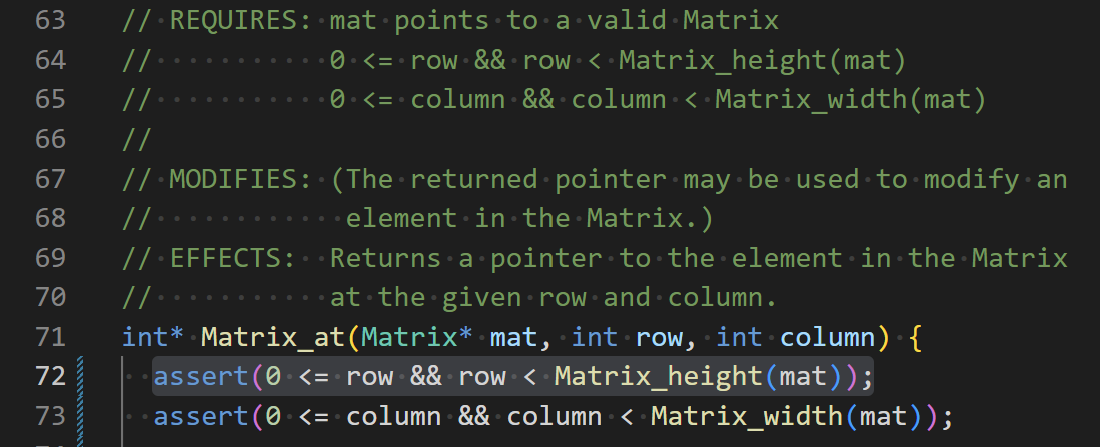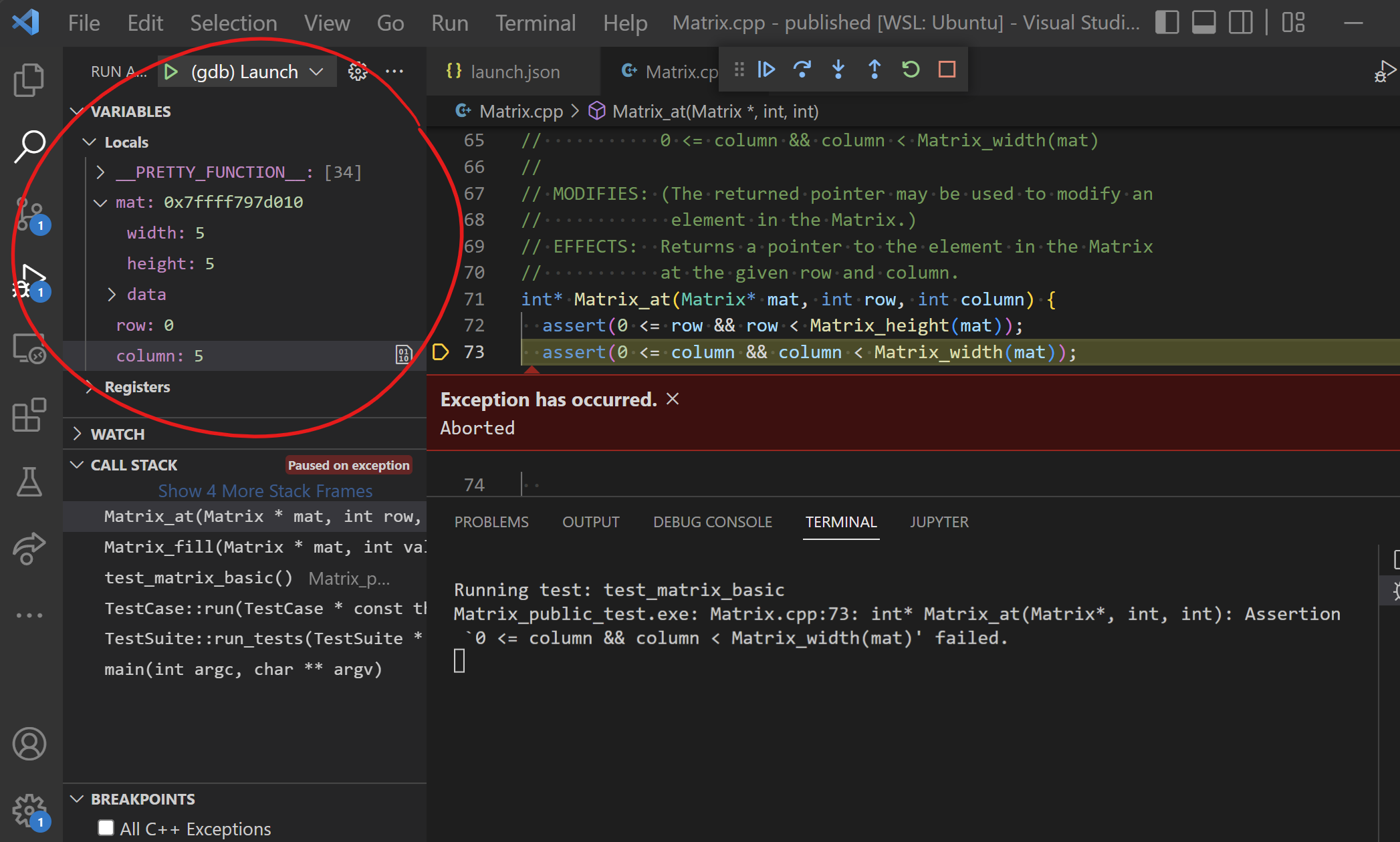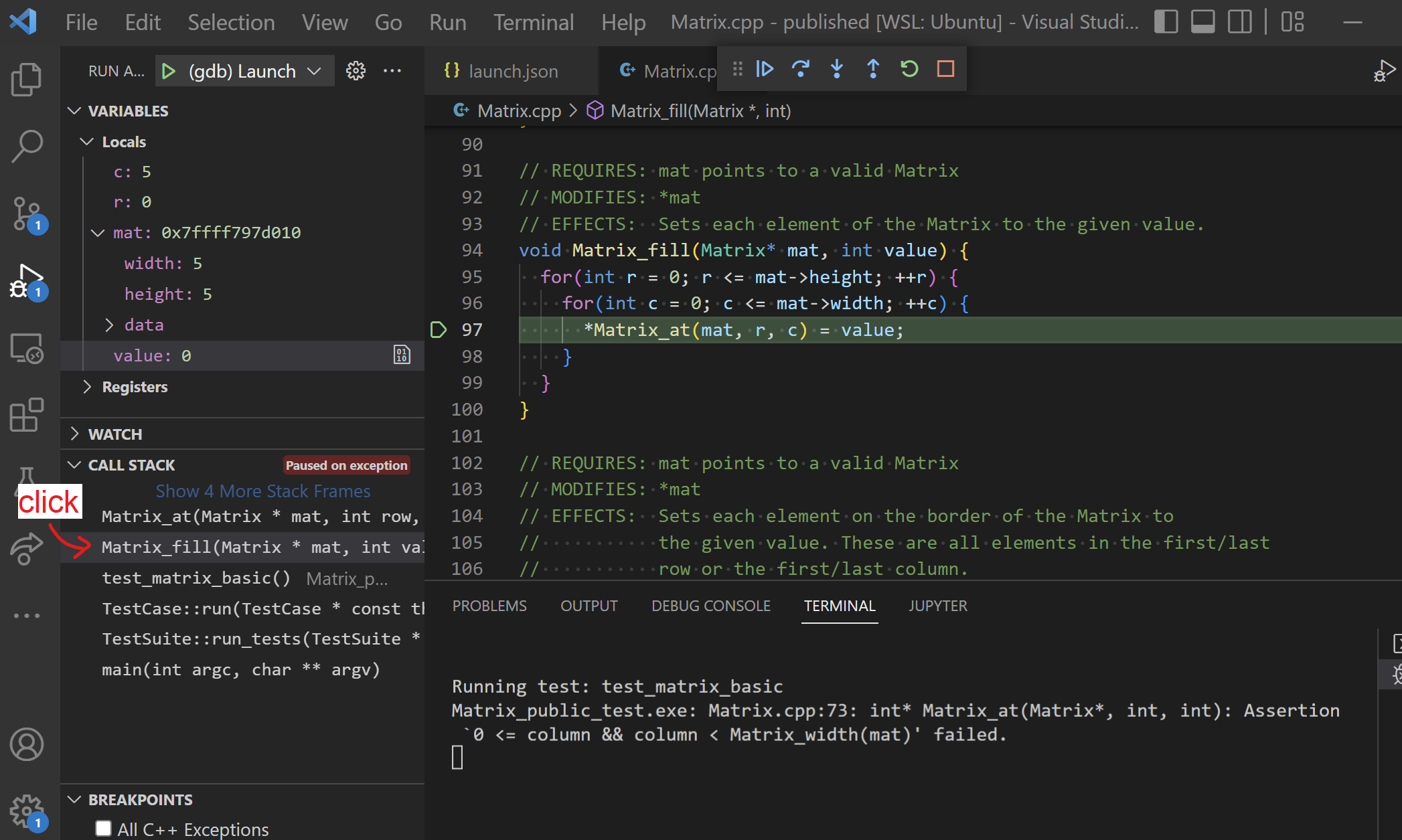EECS 280 Tutorials
Assertions Guide
Assertions are a preemptive debugging tool. Add them to your code to detect bugs before they cause difficult-to-debug problems later in your code.
Using Assertions
The <cassert> header defines an assert() macro that checks a boolean condition:
- If the condition is true, nothing happens.
- If the condition is false, the program crashes immediately.
For example:
// primer-spec-highlight-start
#include <cassert>
// primer-spec-highlight-end
int main() {
int x = 2;
int y = 5;
// primer-spec-highlight-start
assert(x + 3 == y); // true, all good :)
assert(x > y); // false, crash!! (╯°□°)╯︵ ┻━┻
// primer-spec-highlight-end
}
We might see this output when running the above:
test.exe: test.cpp:7: int main(): Assertion `x > y' failed.
Aborted
For debugging purposes, we use assert() to verify our program is behaving as intended and “fail fast” otherwise so that we can get to fixing the bug.
Assertions are intended for debugging, but you don’t have manually remove them before shipping production code. They can be turned off automatically by compiling with the -DNDEBUG flag.
Sanity Check
You might run into situations in your code where you think “this could never happen” - and you’re often right, unless there’s a bug somewhere! Adding assertions to “prevent the impossible” will expose such bugs.
For example, you might find that certain paths through the code are unreachable if everything is working as expected, and you can encode this as an assertion. Here’s an example, pulled from the project 3 specification.
Player * Player_factory(const std::string &name,
const std::string &strategy) {
// We need to check the value of strategy and return
// the corresponding player type.
if (strategy == "Simple") {
// The "new" keyword dynamically allocates an object.
return new SimplePlayer(name);
}
// Repeat for each other type of Player
...
// primer-spec-highlight-start
// Assuming we've checked for each kind of Player
// above, the code should never get here. If we do...
// something is very wrong and the assert lets us know!
assert(false);
// primer-spec-highlight-end
}
The assert(false) here is also helpful to suppress a warning the
compiler might otherwise give because it’s worried our code could reach
the end of the function without returning anything (g++ phrases this as “warning: control reaches end of non-void function”). But, with the assertion,
the end of the function can literally never be reached and the compiler
doesn’t give that warning.
Or, you might write code to ensure some property, like forcing a user to enter a non-negative number. You could add an assertion to verify the code has actually achieved that. Consider this example code:
int get_order_quantity() {
cout << "How many items would you like to order?" << endl;
// Get user input
int quantity;
cin >> quantity;
// Prompt them again if the input was invalid
if (quantity < 0) {
cout << "Invalid input. Please enter a non-negative number." << endl;
cin >> quantity;
}
// primer-spec-highlight-start
// We should have a valid quantity after the user interaction above.
// (Unless there's a bug somewhere - this will sanity check!)
assert(quantity >= 0);
// primer-spec-highlight-end
return quantity;
}
That assertion proves worthwhile, since there is a bug in the code! Because
the if statement only checks the first input for validity, an invalid
negative input for the second cin >> quantity could sneak through. But,
it would be immediately caught by the assertion and is easily debugged.
Verify Preconditions
Use assertions to verify the REQUIRES clause for each
function whenever possible. These are the preconditions that are required
for the function to have a chance of working correctly, so verifying them
up front is a good idea.
Example: Matrix_at() Preconditions
Here’s an example of assertions you could use in function that
provides access to data at a given row/column within a Matrix struct:
// primer-spec-highlight-start
// REQUIRES: mat points to a valid Matrix
// 0 <= row && row < Matrix_height(mat)
// 0 <= column && column < Matrix_width(mat)
// primer-spec-highlight-end
// EFFECTS: Returns a pointer to the element in
// the Matrix at the given row and column.
int* Matrix_at(Matrix* mat, int row, int column) {
// primer-spec-highlight-start
assert(0 <= row && row < mat->height);
assert(0 <= column && column < mat->width);
// primer-spec-highlight-end
// Implementation
// ...
}
If we were to call Matrix_at() with parameters that are outside the
bounds of the Matrix, we get a failed assert right away and can debug
the issue. These assertions are also invaluable while debugging other code
that uses Matrix_at() - if the assertions aren’t failing, you can safely
rule out any out-of-bounds bugs and focus your attention elsewhere.
Of course, you can’t assert every single thing in every REQUIRES clause.
Some of them can’t possibly be checked. Here’s another example:
// REQUIRES: mat points to a valid Matrix
// primer-spec-highlight-start
// the destination array is large enough
// primer-spec-highlight-end
// EFFECTS: Copies all data from the matrix to
// the given destination array
void copy_matrix_to_array(const Matrix* mat, int dest[]) {
// primer-spec-highlight-start
// Verify REQUIRES clause???
// primer-spec-highlight-end
// Implementation
// ...
}
In this case, we can’t use an assert to verify that the destination
array is large enough, because the int[] array parameter decays to
an int * type that doesn’t contain information about the size of
the original array.
Check Invariants
The representation invariants of an abstract data type (ADT) express the
conditions required for its present state to be valid. In other words,
do the member variables of a given struct or class object make sense
in terms of what it’s trying to represent? For example, Some examples:
- In a
Matrixstruct, thewidthandheightmembers should be positive numbers - In a Euchre
Cardclass, thesuitmember must be"spades","hearts","diamonds", or"clubs"
We try to write code carefully so that the representation invariants are set up correctly when an ADT object is created and preserved throughout any operations on it. And we’ll also rely on assuming they are true when we write code to work with the object. We can add assertions to verify those assumptions and fail fast if they’re ever broken.
Example: Matrix ADT
In a C-style ADT implemented with a struct, you can create a general helper to check invariants. For example, consider a Matrix ADT and a corresponding function to check its invariants:
struct Matrix {
int width;
int height;
int data[MAX_MATRIX_WIDTH * MAX_MATRIX_HEIGHT];
};
// EFFECTS: Uses assertions to verify the representation invariants
// for the given Matrix.
void Matrix_check_invariants(const Matrix* mat) {
assert(mat); // Shouldn't be nullptr
assert(0 < mat->width && mat->width <= MAX_MATRIX_WIDTH);
assert(0 < mat->height && mat->height <= MAX_MATRIX_HEIGHT);
}
Then, call it at as needed to proactively sanity check:
// REQUIRES: mat points to a valid Matrix
// EFFECTS: Returns a pointer to the last element (at the
// highest possible row/column) in the Matrix.
int * Matrix_last(Matrix* mat) {
// primer-spec-highlight-start
Matrix_check_invariants(mat);
// primer-spec-highlight-end
return &mat->data[mat->height * mat->width - 1];
}
In the example above, you could think of this as a check on the REQUIRES
clause that specifies mat must point to a valid Matrix. This keeps
us from wasting time if, for example, Matrix_last() appears to be broken
but the problem was really that we forgot to call Matrix_init() previously.
Example: List ADT
In a C++ style class, implement check_invariants() as a private member function. Call it after initializing member variables in the constructor and any time you make changes to your data representation (i.e. the member variables).
Here’s an example for a complex data structure called a linked list, in which individual nodes store data and connect to their neighbors via pointers:
class List {
private:
// Lists contain nodes, connected in a chain using pointers
struct Node {
Node *next;
Node *prev;
int datum;
};
// Member variables
Node *first;
Node *last;
int num_nodes;
// primer-spec-highlight-start
// Check represenation invariants with assert
void check_invariants() {
// Either it's empty with null first/last pointers,
// or it's not empty and neither should be null
assert(!first && !last || first && last);
// There's nothing before the first node
// and nothing after the last node.
assert(first->prev == nullptr);
assert(last->next == nullptr);
// Manually counting the number of nodes matches
// the number we're tracking in num_nodes
int count = 0;
for(Node *n = first; n; n = n->next) {
++count;
}
assert(count == num_nodes);
}
// primer-spec-highlight-end
public:
// Default constructor. Creates an empty list.
List : first(nullptr), last(nullptr), num_nodes(0) {
// primer-spec-highlight-start
check_invariants(); // ensure our list is set up
// primer-spec-highlight-end
}
//EFFECTS: inserts datum into the front of the list
void push_front(const T &datum) {
// A bunch of complicated code that rearranges
// pointers to add a node to the list
// ...
// primer-spec-highlight-start
check_invariants(); // make sure we didn't screw up the pointers
// primer-spec-highlight-end
}
};
Debug Failed Assertions
Let’s say you’re running Image_public_test.exe on project 2 and
one of your Matrix_at() assertions fails:
$ ./Image_public_tests
Running test: test_image_basic
Image_public_test.exe: Matrix.cpp:72: int* Matrix_at(Matrix*, int, int): Assertion `0 <= row && row < Matrix_height(mat)' failed.
Aborted
That’s nice, but just a line number (i.e. Matrix.cpp:72) doesn’t really give us much to go on:

We need more information. Let’s run the code in our visual debugger instead. (You don’t need to add breakpoints, just run it.)
It should pause when the assert fails so that we can inspect the state of the program and figure out why the assertion is failing. First, check the local variables:

It looks like the problem is that the column parameter is too large (given width 5, only 0-4 column indices are allowed). We can figure out where this is coming from by clicking on the the stack frame for the calling context, which is the Matrix_fill() function:

Now we can actually see the call to Matrix_at() that broke its REQUIRES clause. In this implementation of Matrix_fill(), the c variable is allowed to reach value 5, which is one too large. We need to adjust the conditions on the loops to fix this.
Because we had assertions in Matrix_at(), it warned us right away that Matrix_fill() was up to no good!
Assertions for Testing
In this guide, we discuss assertions as a preemptive debugging tool. Assertions are also frequently used for unit testing, often in combination with a unit-testing framework such as the one we provide in EECS 280 that may provide additional constructs like ASSERT_TRUE or ASSERT_EQUAL(). We don’t address that context in this guide, and we don’t recommend mixing those special testing assertions into your code for debugging purposes.
Acknowledgments
Original document written by James Juett jjuett@umich.edu.
This document is licensed under a Creative Commons Attribution-NonCommercial 4.0 License. You’re free to copy and share this document, but not to sell it. You may not share source code provided with this document.